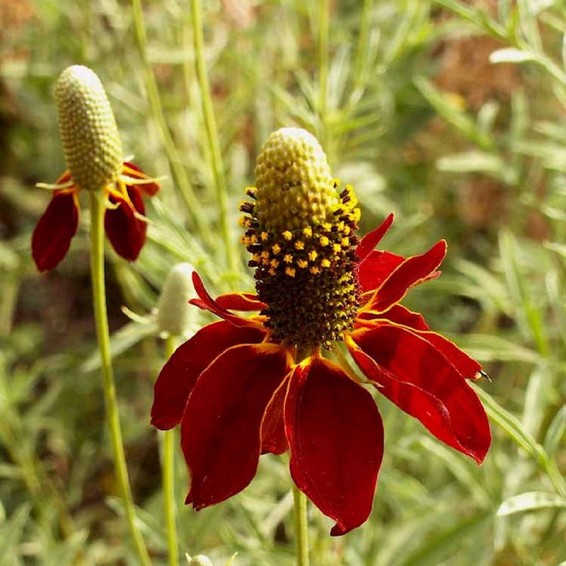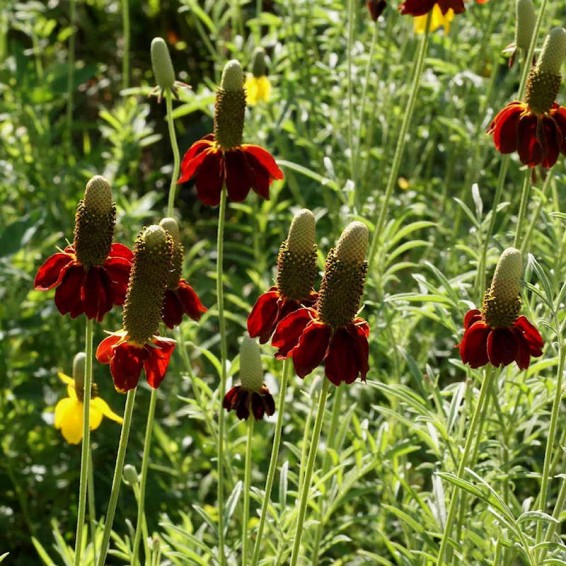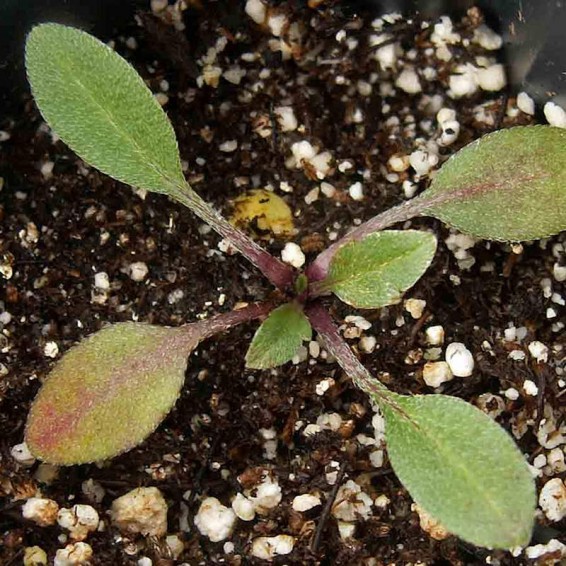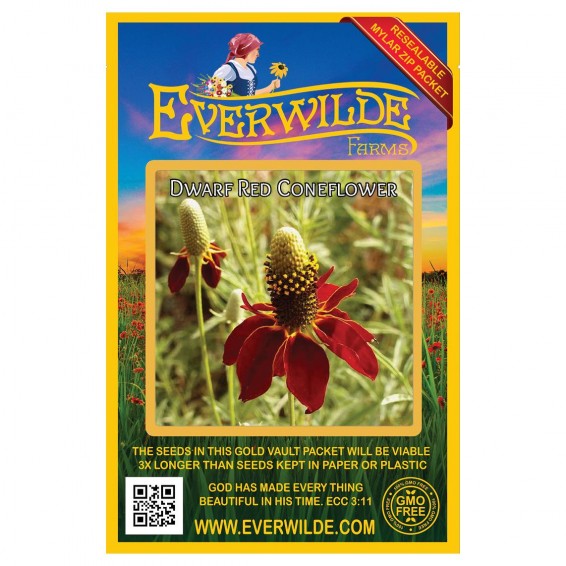Dwarf Red Coneflower Seeds

- HOW TO GROW
- FAST FACTS
- REVIEWS
HOW TO GROW
Sowing: Direct sow in late fall, pressing into the surface of the soil since this plant needs light to germinate. For spring planting, mix the seeds with moist sand and store in the refrigerator for 30 days before planting. Keep the soil lightly moist until germination, which usually takes 3-4 weeks. The seeds can also be started indoors 8-10 weeks before planting in spring. Keep seedlings lightly moist, and transplant them as soon as they have developed several leaves.
Growing: Water seedlings regularly until they become established, and control weeds. When grown from seed, these plants usually begin blooming in their second year. Mature plants tolerate drought well and flourish in fairly dry soil, though they will benefit from occasional watering in dry weather. The blooming period tends to be longer with occasional watering. Mature plants can be divided every 2-3 years for healthy growth. This plant attracts butterflies and repels deer, as well as growing well in rocky, sandy, or clay soil. It makes an excellent choice for hot, dry areas.
Harvesting: For cut flowers, choose stems with flowers that have just opened. Strip the foliage that will fall below the water level, and place in water immediately.
Seed Saving: After the petals fall from the blossom, the cone will darken and develop ripe seed. As soon as the seed turns nearly black and can be rubbed loose from the cone, cut the ripe cones from the plant and spread them to dry. Thresh the plant material to separate the seed from the stems. Store the seed in a cool, dry place.
FAST FACTS
Common Names: Long-head Coneflower, Grey Headed Coneflower, Upright Prairie Coneflower, Red Hats, Thimble flower, Columnar Prairie Coneflower, Mexican Hat
Latin Name: Ratibida columnifera
Species Origin: US Native Wildflower
Type: Native Wildflowers
Life Cycle: Perennial
USDA Zones: 2, 3, 4, 5, 6, 7, 8, 9, 10, 11, 12
US Regions: California, Mountain, Arid/Desert, Plains/Texas, Midwest, Northern, Northeast, Southeast
Seeds per Ounce: 52,000
Stratification: Cold/Wet for 4 Weeks
Germination Ease: Stratify 4 Weeks
Sunlight: Full Sun
Height: 18 Inches
Color: Red, Yellow
Bloom Season: Blooms Early Summer, Blooms Late Summer
Uses: Attracts Pollinators, Attracts Butterflies, Cut Flowers, Deer Resistant
Quality seeds
I buy from Everwilde because they have a good selection of quality seed; dated and well-packaged, with quick delivery. We have a 1.5 acre wildflower field, to which we continue to add additional flowers. We mow it in late October, then broadcast new seeds for winter and then spring germination. Many of these flowers have popped up throughout the field.
EVERY SEED CAME UP
I ordered these back in December 2021. Live in South Florida, so planted out right away. Within 9 days, every single seed came up, and with diligence. I know they take two years to bloom, but it will be worth the wait. The seedlings are very vigorous, and at the time of this posting, are about 1" across. In another month I will transplant them out. Really sturdy stock, excellent germination. Thanks Everwilde, I'm a believer. :)
Hope they grow here
Love the packaging. I won't plant these until late-fall/early-winter and then won't know until next year.
Great Packaging
I'm excited to plant these seeds. It's the first time I've received a mylar seed packet and so beautifully decorated
glad to find Everwilde
I ordered 3 packets of wild flower seeds to put down this fall. I have a small space and don't need to buy seed by the pound, I was glad to find such an assortment of seeds in small quantities from Everwilde. The service was excellent, I am excited to see my wild flowers next spring.
DESCRIPTION
-Distribution-Map.jpg)
HOW TO GROW
Sowing: Direct sow in late fall, pressing into the surface of the soil since this plant needs light to germinate. For spring planting, mix the seeds with moist sand and store in the refrigerator for 30 days before planting. Keep the soil lightly moist until germination, which usually takes 3-4 weeks. The seeds can also be started indoors 8-10 weeks before planting in spring. Keep seedlings lightly moist, and transplant them as soon as they have developed several leaves.
Growing: Water seedlings regularly until they become established, and control weeds. When grown from seed, these plants usually begin blooming in their second year. Mature plants tolerate drought well and flourish in fairly dry soil, though they will benefit from occasional watering in dry weather. The blooming period tends to be longer with occasional watering. Mature plants can be divided every 2-3 years for healthy growth. This plant attracts butterflies and repels deer, as well as growing well in rocky, sandy, or clay soil. It makes an excellent choice for hot, dry areas.
Harvesting: For cut flowers, choose stems with flowers that have just opened. Strip the foliage that will fall below the water level, and place in water immediately.
Seed Saving: After the petals fall from the blossom, the cone will darken and develop ripe seed. As soon as the seed turns nearly black and can be rubbed loose from the cone, cut the ripe cones from the plant and spread them to dry. Thresh the plant material to separate the seed from the stems. Store the seed in a cool, dry place.
FAST FACTS
Common Names: Long-head Coneflower, Grey Headed Coneflower, Upright Prairie Coneflower, Red Hats, Thimble flower, Columnar Prairie Coneflower, Mexican Hat
Latin Name: Ratibida columnifera
Species Origin: US Native Wildflower
Type: Native Wildflowers
Life Cycle: Perennial
USDA Zones: 2, 3, 4, 5, 6, 7, 8, 9, 10, 11, 12
US Regions: California, Mountain, Arid/Desert, Plains/Texas, Midwest, Northern, Northeast, Southeast
Seeds per Ounce: 52,000
Stratification: Cold/Wet for 4 Weeks
Germination Ease: Stratify 4 Weeks
Sunlight: Full Sun
Height: 18 Inches
Color: Red, Yellow
Bloom Season: Blooms Early Summer, Blooms Late Summer
Uses: Attracts Pollinators, Attracts Butterflies, Cut Flowers, Deer Resistant
Reviews
Review
Quality seeds
I buy from Everwilde because they have a good selection of quality seed; dated and well-packaged, with quick delivery. We have a 1.5 acre wildflower field, to which we continue to add additional flowers. We mow it in late October, then broadcast new seeds for winter and then spring germination. Many of these flowers have popped up throughout the field.
Review
EVERY SEED CAME UP
I ordered these back in December 2021. Live in South Florida, so planted out right away. Within 9 days, every single seed came up, and with diligence. I know they take two years to bloom, but it will be worth the wait. The seedlings are very vigorous, and at the time of this posting, are about 1" across. In another month I will transplant them out. Really sturdy stock, excellent germination. Thanks Everwilde, I'm a believer. :)
Review
Hope they grow here
Love the packaging. I won't plant these until late-fall/early-winter and then won't know until next year.
Review
Great Packaging
I'm excited to plant these seeds. It's the first time I've received a mylar seed packet and so beautifully decorated
Review
glad to find Everwilde
I ordered 3 packets of wild flower seeds to put down this fall. I have a small space and don't need to buy seed by the pound, I was glad to find such an assortment of seeds in small quantities from Everwilde. The service was excellent, I am excited to see my wild flowers next spring.










